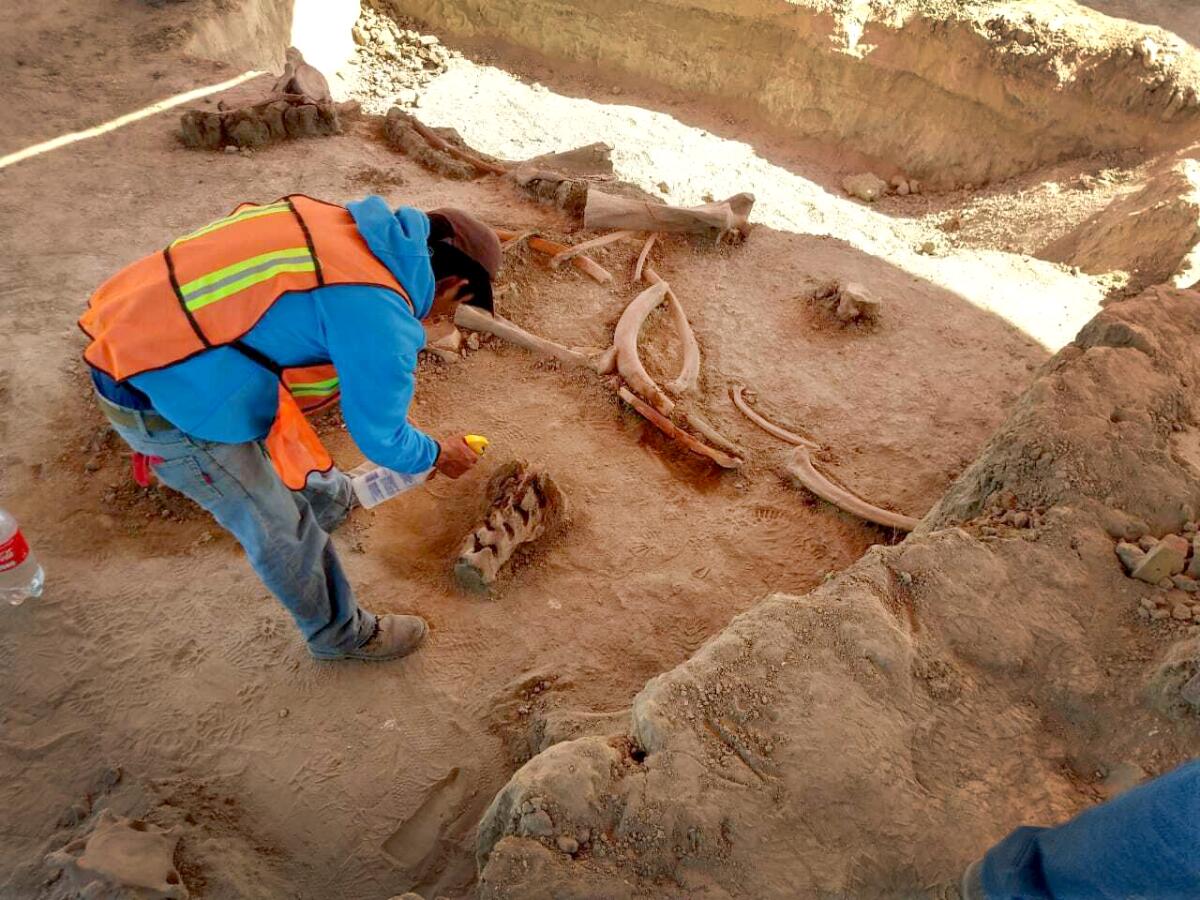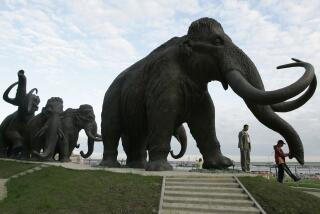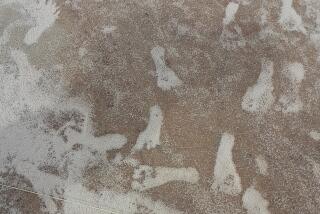Mexico City was once the realm of the mammoth

ZUMPANGO, Mexico â Crouching in the dirt, workers gingerly stripped away layers of sediment with brushes, picks and spatulas, revealing jagged vestiges of a lost world.
âVertebrae,â explained RubĂŠn Manzanilla LĂłpez, the project supervisor, pointing to a row of outsized bones jutting from the ground. âAnd over there is a pelvis.â
In recent months, this airport construction site 30 miles north of Mexico City has yielded an immense cache of bones from one of prehistoryâs most storied creatures â the mammoth, extinct kin of the modern-day elephant.
Digs have turned up the remains of more than 100 males, females and calves, marking one of the largest such discoveries in the Americas.
âI think itâs going to be very significant,â said Dr. Emily L. Lindsey, assistant curator and excavation site director at the La Brea Tar Pits and Museum in Los Angeles. âThese super-large accumulations of remains are not that common and represent a real scientific resource.â
The species found here is the Columbian mammoth, which had long, curved tusks and meandered across a broad range from present-day southern Canada to Central America.
The species â about 13 feet in height and weighing at least 10 tons, slightly larger than todayâs African elephant â lacked the dense fur of its smaller, contemporaneous cousin, the woolly mammoth, which favored cooler climes farther north in the Americas and Eurasia.
Scientists say herds of the plodding pachyderms wandered for millenniums throughout the Valley of Mexico, now a heavily polluted, traffic-clogged megacity that is home to about 22 million people.
In prehistoric times, the high-altitude grasslands, mild weather and ample fresh water â the area was home to five large lakes â provided a haven for the vegetarian behemoths.
The beasts coexisted with camels, horses and other so-called megafauna, as well as alongside Paleoamericans, the regionâs first humans.
Herds of mammoths thrived deep into the late Pleistocene era â which ended about 11,700 years ago â along the shores of Lake Xaltocan, which dried up decades ago and is now part of a semirural exburb that includes the Santa Lucia military base.
The prehistoric trove was discovered on the base as construction began last year on a new civilian airport there, a project that is a priority of President AndrĂŠs Manuel LĂłpez Obrador.
Scientists say that the animals probably got stuck in the mud of the former lake, couldnât drag themselves from the ooze and succumbed to hunger or exhaustion. Scavenging animals, and possibly early humans, probably consumed their corpses.
Over the eons, their bones were dispersed, but were preserved in the earth as the lake retreated.
Last year at another site, nine miles away in the town of Tultepec, researchers found remains of 14 mammoths in trenches that they believe were dug by hunters to trap the animals.
The evidence suggests that nomads used torches and sticks to force the beasts into the 6-foot-deep pits. Once the animals perished, the early Americans butchered the carcasses with tools probably crafted from mammoth bones.
Then they feasted on the flesh, apparently savoring tongues that weighed in at 25 pounds.
âThere are vestiges of mammoths buried all around here,â said Manzanilla, chief archaeologist at the airport site, where scores of workers in hard hats and orange vests scrape through the earth. âWe always knew there had been mammoths here, but we never expected to find so many.â
Their magnificent bones have long been the stuff of myth, inspiring legends among indigenous cultures, while also raising superstitions among Spanish conquistadors who arrived in the 16th century.
In his seminal account, âThe Conquest of New Spain,â Bernal DĂaz del Castillo chronicled how the mysterious remains resonated in the oral history of the Tlaxcalan civilization of central Mexico.
He wrote that the Tlaxcalan people told the Spaniards stories about an evil race of âvery tall men and women with huge bones [who] had once dwelt among them,â and, as evidence, produced a sample of colossal bones, apparently of mammoth provenance, including a leg bone as tall as man.
âWe were all astonished by the sight of these bones and felt certain there must have been giants in that land,â DĂaz wrote.
HernĂĄn CortĂŠs, who led the Spanish conquest of the Aztec Empire, himself ordered that a prodigious leg bone be sent back to Spain, DĂaz wrote, âso that His Majesty may see it.â
In modern times, workers excavating for the Mexico City subway in the 1970s also unearthed mammoth bones. Some remain on exhibit in a glass case at the metroâs TalismĂĄn station, which features the stylized image of a mammoth as its logo.
The Columbian mammoth vanished at the end of the last Ice Age. But recent research suggests that a population of woolly mammoths endured in the Arctic on what is now Russiaâs Wrangel Island until as late as 2000 BC, meaning some were still slogging about as the first Egyptian pyramids were being built.
It is unclear what killed off the mammoths and other megafauna. Some speculate about a calamitous meteorite strike. But experts tend to believe it was a lethal combination of habitat loss due to climate change as the glaciers retreated and human depredation.
âWe suppose that there were terrible droughts,â Manzanilla said. âPerhaps the conditions changed, there was little rain, and without the rain there was no grass, no food.â
Digging at the airport site has also turned up the bones of lone-gone American camels, horses, bison and fish â along with a partial claw of a bear or a large feline.
Mexican officials have ambitious plans to continue excavation, preservation and study of the mammoth bones, which are to be housed in a museum at the new airport. The exhibit would trace the siteâs evolution from habitat of a late-Pleistocene menagerie to homeland of various pre-Columbian cultures to its colonial incarnation, when the zone housed a Jesuit foundation before the crown expelled the Catholic order from Mexico in 1767.
Authorities say the digs have not slowed the construction of a terminal building and other facilities at the new airport, which is scheduled to open in 2022.
The discoveries here present a rare opportunity to ârecover more than 20,000 years of history,â said JoaquĂn Arroyo Cabrales, a paleontologist working on the project. âAnd perhaps understand better the causes of extinction ⌠and the possible human interactions with these animals.â
Cecilia SĂĄnchez in The Timesâ Mexico City bureau contributed to this report.
More to Read
Sign up for Essential California
The most important California stories and recommendations in your inbox every morning.
You may occasionally receive promotional content from the Los Angeles Times.










